The Best Fall Crops to Grow in Fall Vegetable Garden (and When to Plant Fall Vegetables)
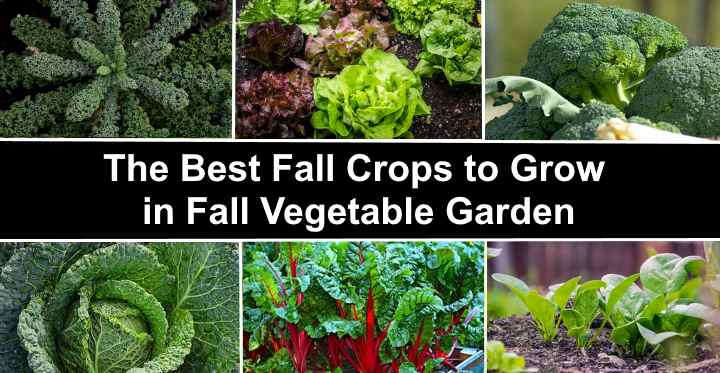
Planting vegetables to harvest in the fall lets you enjoy healthy, fresh vegetables long after hot summer days have passed. The time to plant fall crops is in mid- to late-summer. This gives your fall root vegetables and leafy greens time to grow and mature. Then, in your fall vegetable garden, you can have delicious crops such as kale, Swiss chard, carrots, broccoli, beets, peas, and cauliflower ready for picking.
Most fall vegetables are ready for harvesting before the first frost. However, depending on the type and cultivar, some vegetables last well into winter. The good news is that planting vegetables to harvest in the fall is relatively easy. In fact, some fall garden vegetables are tastier when they grow in cold weather.
This article is a guide to knowing the best fall garden vegetables to grow. Along with descriptions of these tasty vegetables, you’ll find out when to plant vegetables that are ready for picking from late September to early December.
When to Plant Fall Garden Vegetable Plants
Late July and early August is usually the best time to plant vegetables for a fall garden. Fall vegetables such as parsnips, lettuce, collards, spinach, and cabbage need time to mature before freezing temperatures set in. So, the longer, warmer days of late summer are ideal for getting your vegetables started in the ground.
Before planting vegetables for harvesting in the fall, it’s crucial to pay attention to the vegetable cultivars. Some delicious cool-weather vegetable varieties are specially selected to grow in colder weather. That way, you don’t have to worry about frost damaging your fall garden plants.
Another consideration when planting vegetables that grow in the fall is your growing zone. Typically, if you live in USDA zones 4 through 6, you should look for the hardiest fall crops to plant in late summer.
The time to plant cool-weather crops is generally given as the number of weeks before the first frost date in your region.
What to Plant in the Fall Garden
The best crops for planting in late summer for a fall harvest are ones that mature quickly. Varieties of cool-weather green leafy vegetables, root vegetables, and vegetables from the cabbage family are perfect for a fall garden.
The best leafy greens to plant for harvesting in the fall include Swiss chard, kale, collards, arugula, lettuce, bok choy, and mustard greens.
Root vegetables are some of the easiest fall vegetables to plant in July and August. Examples of delicious fall root vegetables are carrots, parsnips, winter radishes, turnips, and beets.
A fall garden wouldn’t be complete without vegetables that are related to cabbages in the genus Brassica. Some delicious types of vegetables for a fall harvest include savoy cabbage, broccoli, kohlrabi, Brussels sprouts, and cauliflower.
The Best Fall Crops to Grow in The Fall Vegetable Garden
Are you wondering about the best vegetables to plant after your summer harvest? Here is a guide to the best fall crops that are ready for harvesting between late September and December.
Kale (Brassica oleracea)

There are various types of kale that are great as fall vegetables to plant in a fall garden
Planting kale near the end of summer gives a bumper crop of super-healthy greens in late fall and early winter. Kale is a cold-hardy annual vegetable that survives freezing temperatures. Kale becomes tastier after frost, and you may want to leave some for harvesting from your winter vegetable garden.
Various kale varieties are ideal for fall gardens. For example, in August, you can plant types of kale such as curly-leaf kale, red Russian kale, or bumpy-leaf kale.
Kale grows well in USDA zones 7 through 9 and grows up to 2 ft. (0.6 m) tall and wide.
When to plant kale: For a fall harvest, plant kale about six to eight weeks before the first frost date. Kale grows best in full sun to partial shade.
Swiss Chard (Beta vulgaris subsp. vulgaris)
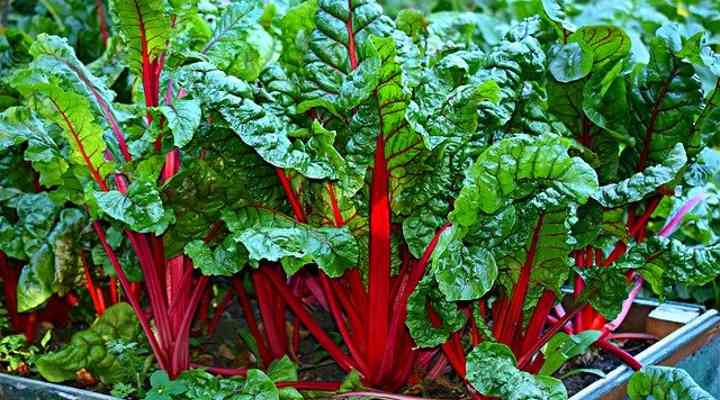
Swiss chard can tolerate light frosts
Swiss chard is an excellent fall crop because it can tolerate light frosts in the fall. You have to plant Swiss chard in early or mid summer for a fall harvest.
Swiss chard is a green leafy vegetable with bright red or yellow stalks and veins. Related to beets, cold-friendly Swiss chard is grown for its tasty leaves. You can eat the leaves raw, sauteed, or boiled, or add to soups.
Swiss chard grows as an annual vegetable in USDA zones 3 through 10.
When to plant Swiss chard: Plant Swiss chard about ten weeks before the first frost is expected. This cool-weather vegetable grows best in full sun or partial shade.
Lettuce (Lactuca sativa)

Lettuce is an excellent vegetable for a fall harvest – it needs some protection from frost in winter
Sow lettuce in late summer so that it grows through the fall and into winter. This leafy green needs some protection from frost to survive winter. As an annual green-leafy fall vegetable, lettuce is perfect for harvesting in cool fall temperatures. Various types of lettuce are usually eaten raw in sandwiches, salads, or as an addition to various cooked dishes.
Lettuce grows well in USDA zones 4 through 9.
When to plant lettuce: The best time to plant lettuce for a fall harvest is four to eight weeks before frost is expected. If you plan to grow lettuce throughout fall and into winter, grow it in a cold frame.
Collard Greens (Brassica oleracea var. Acephala)
Collards are related to cabbage and kale and are tastiest when harvested in late fall. In warmer regions, collards will grow in a vegetable patch throughout the year. In colder climates, collards are a nutritious fall vegetable for planting in late summer. Use collard green in stir-fries, soups, and stews.
In colder regions, plant cold-hardy collards if you want to harvest the crop in late fall. Collard greens become more delicious after the first frost.
When to plant collards: Plant collard greens six to eight weeks before the first frost date.
Bok Choy (Brassica rapa var. Chinensis)
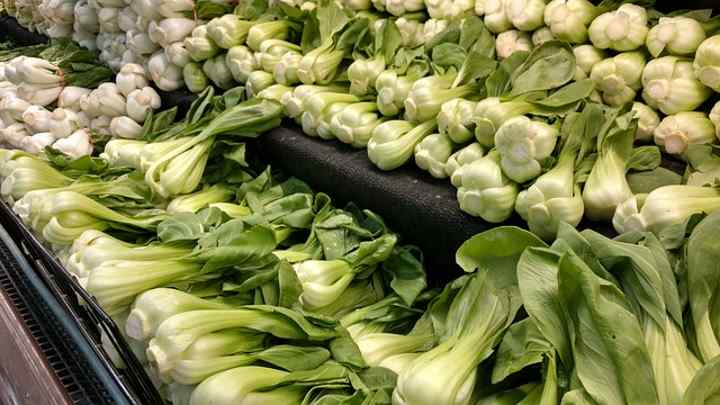
Bok choy in an excellent fall crop. Plant bok choy in mid summer and harvest in the fall
To ensure an excellent fall harvest, plant bok choy in the middle of summer. Also called pak choy, this cool-season cabbage variety is native to Asia. Although a member of the cabbage family, bok choy grows as a bulbous vegetable with relatively small broad, oval leaves. You can use the tasty green leaves in stir-fries, stews, and soups.
Bok choy is cold-hardy in zones 4 through 7.
When to plant bok choy: For a fall harvest plant bok choy in late July; the “white vegetable” takes two months to mature.
Arugula (Eruca vesicaria)
The best way to plant arugula is to sow the seed at intervals throughout the summer for picking in the fall. That way, you will have a continuous supply of these peppery leaves to add to fresh salads in October and November. Also called garden rocket, arugula grows as a tender annual and is a small leafy plant in the cabbage family Brassicaceae.
Arugula is an annual plant that grows in USDA zones 3 through 11.
When to plant arugula: Plant arugula seeds in late fall at two-week intervals.
Spinach (Spinacia oleracea)

Grow spinach in full sun in the end of summer to enjoy it as a fall vegetable
Plant spinach near the end of summer to enjoy its healthy leaves in the fall from October until December. Spinach grows as an annual plant and has broad edible leaves. This hardy fall vegetable can also survive the first winter frosts if it matures early enough. If you only harvest the outer leaves in the fall, the plant will continue growing until the first hard frost.
As a cool-season vegetable, spinach thrives in zones 2 through 9. In the coldest regions, grow spinach in a cold frame or under a row cover to survive late fall temperatures.
When to plant spinach: Plant spinach in full sun between four and eight weeks before the first frost date.
Broccoli (Brassica oleracea var. Italica)

Broccoli grows better in colder climates
Broccoli is a delicious fall vegetable when planted near the end of summer. Broccoli matures better in cold weather and grows best in temperatures between 40°F and 70°F (4°C and 21°C). Light frosts in late fall enhance the taste of broccoli, giving it a sweeter flavor.
Generally, broccoli grows as a cool-season annual plant in USDA zones 2 through 9 for harvesting in the fall. However, some varieties of broccoli grow as perennial vegetables.
When to plant broccoli: Start broccoli as seeds indoors about 12 weeks before the first frost. Transplant to your fall garden about three weeks after planting.
Cabbage (Brassica oleracea)
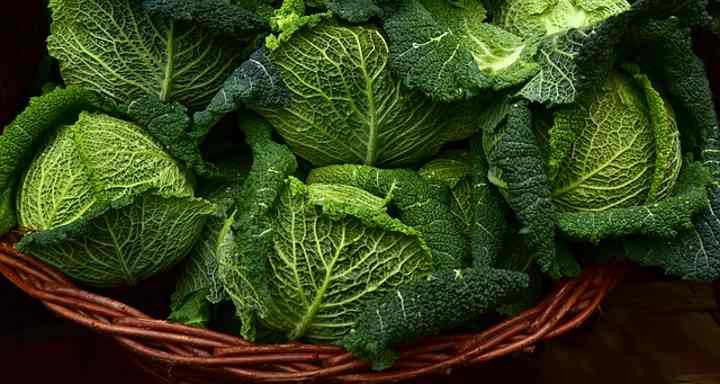
Savoy cabbage is a good addition to your fall vegetable garden
Cabbage is one of the most common seasonal vegetables for harvesting in the fall. Cabbages planted in late summer can usually survive through hard winter frosts and temperatures as low as 20°F (-6°C). There are various types of cabbages you can grow as a fall vegetable. These include savoy cabbage, red cabbage, or loose-leafed cabbage.
Cabbages grow in the coldest climates if you plant them early enough. Cabbage is suitable for growing in zones 1 through 9.
When to plant cabbage: Sow cabbage seeds indoors in summer, around six to 12 weeks before the first frost. After four weeks indoors, transplant cabbage seedlings to your fall vegetable garden.
Cauliflower (Brassica oleracea var. Botrytis)

Cauliflowers in various colors
Cauliflower is a fall crop that you can plant in late summer. As a Brassica genus, cauliflower is closely related to cabbage, broccoli, and Brussels sprouts. To enjoy the most delicious cauliflowers from your vegetable patch, plant them in your garden at the end of summer. Heat tends to affect the color and taste of cauliflower.
Similar to most vegetables in the family Brassicaceae, cauliflower grows well in USDA zones 2 through 11. Cauliflower needs full sun to grow best.
When to plant cauliflower: Cauliflower takes between seven and 12 weeks to mature. Start cauliflower seeds indoors about 12 weeks before the frost date. Then transfer the fall vegetable outdoors between six and eight weeks before frost is expected.
Brussels Sprouts (Brassica oleracea var. Gemmifera)
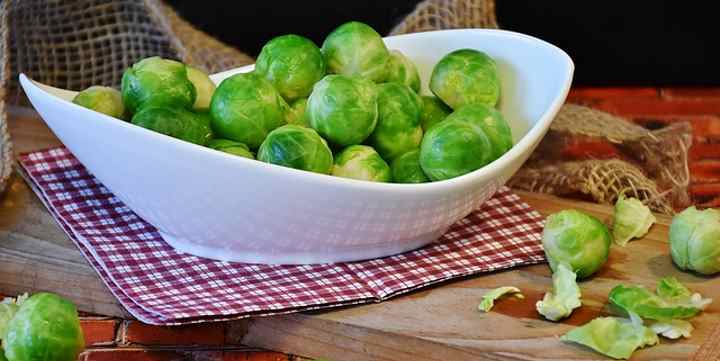
For better taste, harvest Brussels sprouts after the first frost
Brussels sprouts are ready for a fall harvest when planted in the cooler days of late summer. These miniature cabbages growing on stalks grow best when the temperatures between 60°F and 64°F (15° – 18°C). However, once mature, Brussels sprouts survive hard frosts and even snow.
Brussels sprouts are hardy in zones 2 through 9. For the tastiest ‘sprouts,’ harvest them after the first frost.
When to plant Brussels sprouts: For a fall crop of Brussels sprouts, plant them in the ground around late June. This time to plant should be about four months before the frost date.
Carrots (Daucus carota)

Carrots is a great fall vegetable that can tolerate light frosts
Carrots are excellent cool-season root vegetables that grow throughout the fall. Planted in the heat of summer, carrots mature in the ground and are ready for picking two to three months after planting. If carrots have matured by fall, they will continue to grow despite a few light frosts.
In warmer regions, carrots will grow throughout the winter if you protect them with mulch.
Carrots are ideal for growing in fall vegetable patches in USDA zones 3 through 10.
When to plant carrots: Depending on the cultivar, plant carrot seeds in your garden two to four months before the first frost is due.
Parsley (Petroselinum crispum)

Plant parsley in late summer and harvest by late fall
Parsley is a delicious fall herb that is cold-hardy to 10°F (-12°C). Planting parsley toward the end of summer means the tasty green leaves will be ready by late fall. The types of parsley suitable for fall vegetable gardens are flat-leaf parsley and curly leaf parsley. You can also add parsley root to hearty fall stews and casseroles.
Parsley thrives in USDA zones 4 through 9.
When to plant parsley: Plant parsley around ten weeks before the first frost date.
Turnips (Brassica rapa)
Turnips are one of the most popular fall vegetables as they grow fast in cooler temperatures. This fall-ready vegetable has a solid white taproot and tasty edible leaves that taste like mustard greens. Turnips harvested in early fall when they are smaller are generally sweeter than late-fall harvested turnips.
Turnips thrive in USDA zones 2 through 9 and grow best in full sun or partial shade in warmer climates.
When to plant turnips: To enjoy a fall harvest, plant turnips around eight weeks before the first frost is expected.
Beets (Beta vulgaris)

Enjoy the leaves and roots of beets in your fall vegetable garden
Beets are vegetables that are ready for harvesting in the fall. Beets are popular for planting in fall gardens because this cool-season vegetable has delicious edible leaves and a dark red edible root. For a hearty fall meal, you can eat beets boiled, steamed, or pickled. Beets are popular in many northern regions because they grow well in the cold.
Beets grow best in USDA zones 2 through 11. Beets can survive freezing temperatures as low as 20°F (-6°C).
When to plant beets: To harvest beet during the fall, plant them directly in your garden eight to ten weeks before the first frost.
Radishes (Raphanus raphanistrum)
Radishes mature fast for fall harvesting when planted in late summer. The small spicy root vegetable can still be harvested well after the first frost. It takes between six and seven weeks for fall radishes to mature. To enjoy fresh radishes during fall and winter, plant the root vegetables a week or two apart.
Cool-season radishes thrive in fall vegetable gardens in USDA zones 2 through 10.
When to plant radishes: To enjoy radishes long after summer has passed, plant them in your fall vegetable garden about four weeks before the first frost date.
Leeks (Allium ampeloprasum)
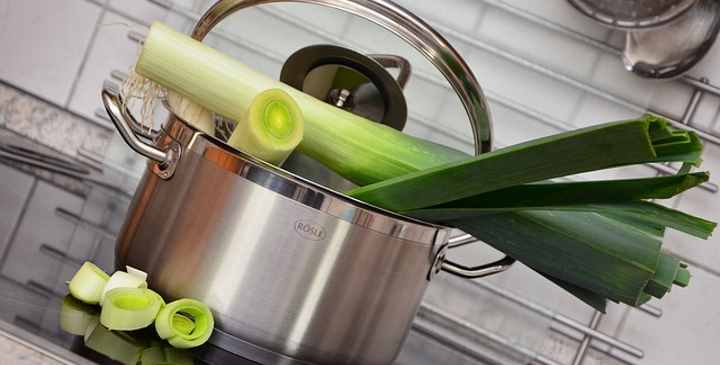
Leek is a delicious fall vegetable to add to soups and vegetable dishes
Leeks are a vegetable that tastes better when planted in summer and harvested in fall. Leeks are related to onions and have long sheath-like leaves that grow upright. Most varieties of leeks are ready for picking in the fall months.
As a cold-hardy vegetable, leeks withstand heavy frost if you provide plenty of mulch. In warmer climates, you can harvest leeks throughout the winter and into spring.
Leeks grow best in full sun and are suitable for growing in fall vegetable gardens in USDA zones 5 through 10.
When to plant leeks: For a fall crop, sow leeks indoors three to four months before the first frost. Plant in the ground in late summer for a fall or winter harvest.
Bunching Onions (Allium)
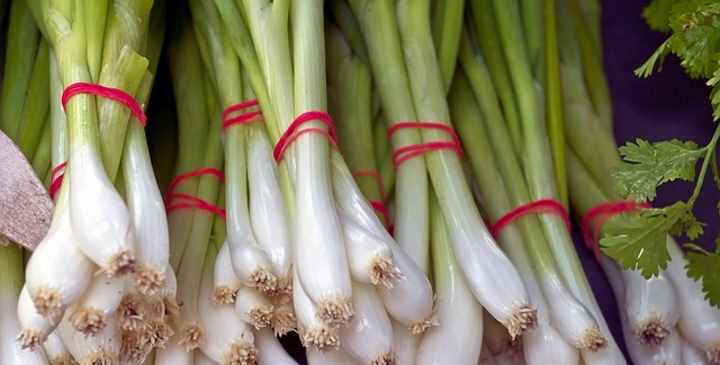
Scallions or Green Onion
Also called scallions or spring onions, bunching onions are an easy vegetable to plant in a fall garden. This perennial fall vegetable grows year after year if you provide protection from hard frost. Scallions have many culinary uses and are popular to use in place of brown onions due to their milder taste.
Bunching onions are an ideal vegetable for planting as a fall crop if you live in USDA zones 5 through 9.
When to plant scallions: To harvest scallions in the fall, plant them about two months before the frost date. In zones 5 and 6, provide protection during severe winters so that the onions continue to grow the following spring.
Peas (Pisum sativum)

Plant peas in late summer and harvest them before the first frost
Peas are tasty vegetables for harvesting in a fall vegetable garden. Although many consider peas a spring garden plant, you can plant peas for picking before the first frost. However, peas can be tricky to grow in the fall. Too much summer heat or an early fall frost can damage the half-hardy vegetables. During hot weather, provide them with shade and plenty of water.
Plant peas in late summer and harvest them before the first frost.
When to plant peas: Plant peas in your fall vegetable patch about three months before frost is due. Provide extra care if you have a warm spell late in the summer.
Related articles:
